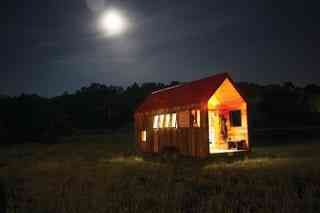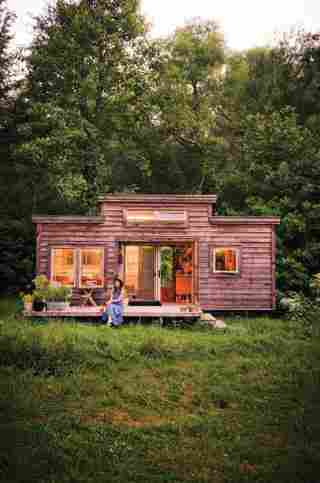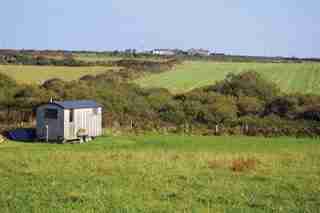It’s no secret: The blogosphere has become obsessed with tiny houses . Blame it on skyrocketing real-estate prices and shrinking city lots, but skinny, mini, and smartly designed have suddenly become serious selling points. With eco-friendly building simultaneously on the rise, it’s no shocker that Ryan Adams—the Charlotte, North Carolina blogger behind The Tiny Life —has released a new book called Tiny Houses Built with Recycled Materials (Adams Media; $27) that catalogues minuscule homes, from a corrugated metal-clad cabin in the mountains of Colorado to a mud hut in Oregon.

Architect Aaron Maret used reclaimed barn wood for the façade, a salvaged door from a 1920s farmhouse, and recovered sheathing from an art studio, but he did buy a few new fixtures, such as operable windows, wiring, and plumbing.

Natalie Pollard’s 265-square-foot house in Asheville, North Carolina, was built from locally milled lumber, with accent walls sheathed in reclaimed materials from a Civil War–era cabin and flooring from a local salvage store.

Inspired by old railway cars and shepherd’s wagons, Kate Fox and Andy Gill devised a house on wheels that accommodates their nomadic lifestyle. They used reclaimed Victorian-era wood for the floorboards and salvaged barn wood for the studs in the walls.
For the DIY caravan James Galletly built in his native Australia, he would post listings of what he needed on social media and regularly found donated supplies—from insulation to flooring samples to the perfect hardware for his French doors—waiting by his job site the next morning.
Greg Parham fashioned corrugated-metal roofing panels and reclaimed wood into walls for his house on wheels in Durango, Colorado.
For her 144-square-foot house on wheels in Washington, Makayla Cavanagh used salvaged lumber from a construction site, several old buildings, and a local store that sells reclaimed materials.
Gareth Roberts—who went on to launch Hummingbird Micro Homes, a tiny-house company in Fernie, British Columbia—starts with a standard frame and works with secondhand materials that he finds on Kijiji, the Canadian version of Craigslist, or on the side of the road.
When San Francisco rents skyrocketed, Blaine and Mackenzie Vossler took their clothing and leather goods business—the Local Branch—on the road in a 240-square-foot 1978 Airstream, which now serves as their live-work space.
Conrad Rogue has been building eco-friendly cabins for most of his adult life. Now he focuses on cob homes, earthen structures like this one that are built from a mix of clay, sand, and straw. He currently lives in his own cob house that measures in at a diminutive 70 square feet.
